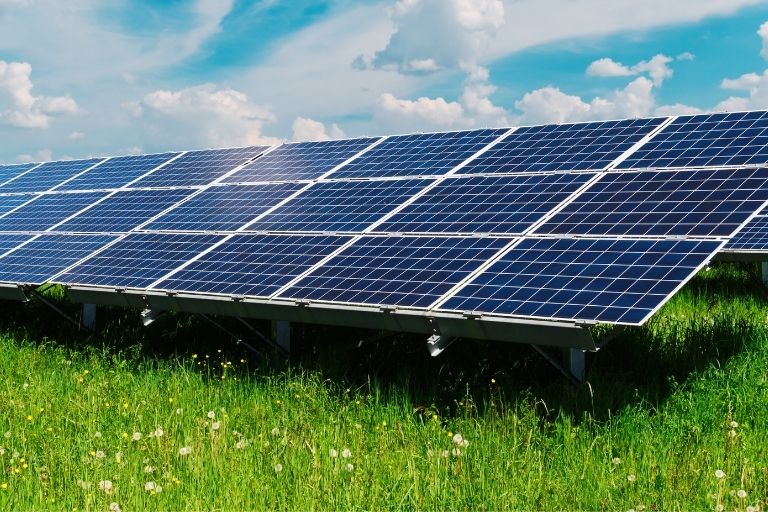Why you should buy your Mother a solar power system instead of a pot plan
Welcome to a mother’s day special toolbox tech talk. Why should you buy your mother a solar power system and not a pot plant? There’s some serious logic behind it. You might actually want her to have cheaper electricity but there’s going to be a discussion about the economics of solar. We’ve been a bit obsessed with our latest little addition to SolarPlus, some 3D mapping.
A question we get a lot from the public when we give public talks is, should I get solar? Yes! Why would you want to miss out? Electricity is really expensive. Doing nothing is a bad economic decision in almost every case. This is Australia, it is just a kind of a no-brainer go solar country and we’re lucky in that respect. We’ve got a lot of good installers out there, we’ve got a lot of good options, we’ve got great prices on products, great incentives and great sunshine. Why wouldn’t you? We guess what a lot of installers struggle with is the quality question and getting compared to prices that people may see offered on tv, having to have that perhaps long and tedious argument, a discussion for some installers about why you need to spend a bit more for good quality. That’s a big issue that we have coming up constantly.
What size solar system should you get?
Should I get solar, what size system should I get? It’s become really common for most offers in solar to provide a 6.6 kilowatt system. It’s kind of the de facto now for residential. Why 6.6? Why not 6.7? 6.6 is an almost accidental convention because of CEC guidelines rule that installers have to follow and that has to be followed if you’re going to get the STC rebate that comes off the price of a system.
Everybody wants that discount and so as a result there’s a limit on the size of the solar panel array that’s going on the roof in relation to the inverter that’s going to give you generally five kilowatt output for your appliances at home.
The solar panels are putting out so much power but there’s losses that come about through the system. Generally you’re going to have losses in the range of between 70% and 80% and so there’s really only about five kilowatts usable power there from that array. There’s a benefit to the STC program that we’re talking about also in terms of the inspections and the enforcing of quality standards that comes about as a result. The federal government through a department called the clean energy regulator are providing inspections on a random basis but a large number of inspections across the country for those systems that have been sold with STC discounts of the price. Those inspections mean you follow up on the installers that are all accredited through the Clean Energy Council. The vast majority do a great job, do the right thing, follow the Australian standards.
It’s a big burden to installers to keep track of all of those regulations and the layers of regulations that they have to deal with. The clean energy regulator inspections that happen after an install are just an extra layer where they might pick up some things that installers need to follow up on. They might need to go back and make some adjustments to the system. In some cases they’ll consider a system substandard, it’s not up to the letter of the law and in extreme cases they might consider a system unsafe and that’s where they’ll immediately make sure that the installer gets onto it, goes out and rectifies the situation.
So the answer to the question should you get solar or not is always yes.
If you are looking at a payback period of a few years now that’s another consideration. lf you’re
owning the house for one year, we imagine it’s unlikely. It might add value to the property though but you know with modeling we can kind of do the economics and make it a more predictable return on investment.
Benefits of Solar
One of the benefits with solar is in most cases it is a very reliable investment that you can consider over a lifetime up to 25-30 years. There are some solar panel manufacturers who provide performance warranties. That’s a warranty in terms of the actual production of the system over a 30-year period but most common is 25 years where you’ve got some guarantee of performance.
A few years ago there were far more manufacturers in the market in Australia and at that time there was a lot of mostly Chinese companies who hadn’t been around that long. Perhaps you couldn’t expect that those companies would be around in another 25 years to guarantee and back up that warranty but these days there are far more manufacturers going through the
process of getting their products certified with the Clean Energy Council. There is a lot greater reliability in those warranties.
On the 18th of December this year there’s going to be a big clean out of inverters because of the requirements for compliance to the 2020 4777.2 standard. It was given a one-year adoption period so we think it’s the 18th of December this year that will come into force. The CEC have already made it clear that approved inverters on their list that are extending beyond that date the approval date will be wound back to the 18th December so they’ll need to be tested and re-listed as compliant to the new standard. We imagine a lot will drop off and choose not to relist. There’s a cost to that for manufacturers and there’s some work in maintaining the certification standard for them.
Solar Warranties
We are in a good position in terms of the warranties that most manufacturers are providing, certainly competition in the market that’s pushing manufacturers to extend the product warranty as opposed to the performance warranty. To clarify the product warranty is the period for which they will guarantee the product as a whole as opposed to the output of the system and so this can be anything from 10 to 25 years for the product warranty.
You’ll sometimes see ads saying 25 year warranty but it’s probably misleading. In many cases, it’s not a full 25-year product warranty, it’s often a 10-year product warranty with 25 years performance up to something like 80% of the stated nameplate values for the power output at the time that it’s sold or that the panel is rated at. This is good advice to anyone buying their mama solar power system, to check the conditions on the warranty. If they’re saying something like 25 year warranty, check whether that’s a performance warranty or a product warranty because it’s a very different thing. The product warranty is probably what you’re most concerned with. Is it going to fall apart? For the performance warranty, if it does last the distance, it’s still going to perform to a certain level.
There’s an interesting characteristic about solar panels too in terms of the degradation in the power output over time. Most panels will have a fast drop off in production in the first year. It can be up to two percent so in some of the performance warranties there’s an allowance for a two percent drop off in power in that first year and then it levels off. After that initial reduction in performance things settle in and it’s just got a lower degradation over the rest of those 25 years and that might be just half a percent per year somewhere around the range generally of 0.3 on the low side for really good quality panels up to maybe 0.6, 0.65, possibly even a little higher for for lower quality panels.
How do you know that the company’s going to be around to honor the warranty? It’s all very well that the product has a warranty. You might want to look at the company’s history, how long have they been in business, are they directly importing, what happens if there is a failure, can you go back to the manufacturer if they have an office in Australia? Generally, that’s yes, you can go back to the manufacturer but if they’re just a direct import with no office in Australia, if that company folds, you’ve lost your warranty. You can go and try and chase them but good luck.
On that point, SolarQuotes is a provider you can go and get a few quotes from. Get three quotes from different installers in your area for the system. They actually have on their site some really interesting information, lots of good info for someone who’s just investigating.
But there might be more cases of panels where there might be a fault over that 25-year period and you might have to fall back on the warranty. There’s also something called an express warranty which is really to do with Australian consumer law when a company or a person makes a claim that an ordinary person would understand to have a meaning of a guarantee. And so if you get a salesman saying these panels will last 30 years but there’s nothing in writing elsewhere, that’s actually an express warranty so they’re supposed to be held to. It’s pretty dodgy. In terms of selling techniques, we’ve seen some appalling things happen in Australia and it’s not only in Australia but it has been an issue for the whole solar industry in terms of its reputation.
It’s quite comforting to see that a lot of solar installers are signing up for the Clean Energy Council approved retailer program where they have to commit to a higher standard in terms of their sales techniques, what they put in their marketing, what they put in their quotes. All in all, we’re seeing the result for consumers improving. There is still the odd player that doesn’t do the right thing and gets caught out but I think that’s one of the benefits that there are people that are being caught out if they’re not doing the right thing. We saw this week in Victoria, a prominent solar company getting this stick as a result of aggressive sales technique, door-to-door knocking, making unsubstantiated claims. It’s not unique to solar. It exists in other areas too but that’s one to be aware of, the door-to-door knockers.
The SolarPlus CRM and Solar Design System
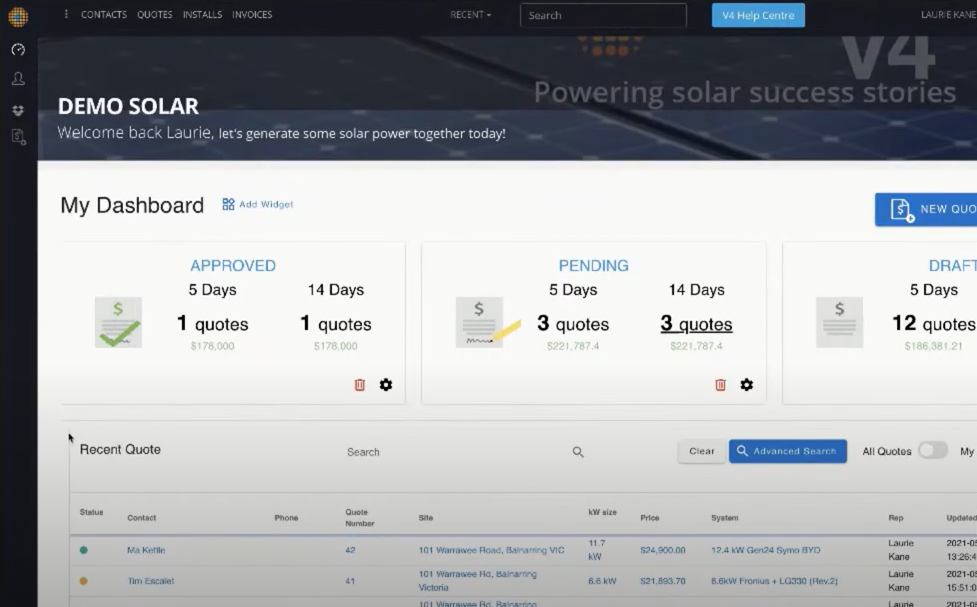
There are ways that installers and designers can give a much better proposition to potential customers out there when they’re thinking about getting solar installed. Our solution is to use software, specifically SolarPlus. SolarPlus is a solar CRM and design software. It’s aimed at solar installers and companies that sell solar. This is not an end-user product and if you’re buying solar you wouldn’t be using this, but you could expect to have something that gives you a quality proposal. This is an example of software that can do that. Check out our features here.
Some of the key benefits for installers in using software such as SolarPlus is the ability to keep track and manage your pipeline through the sales process and through the installation process. It’s really important that the ball doesn’t get dropped on any customer or even managing prospects, seeing who you’ve got in your sales pipeline and so that’s one of the cool things about something like SolarPlus where you’ve got a full customer management system or CRM. You can keep track of all of these customers and where they’re at and you’ve got to-do lists so you can manage your communication with the customer and follow up on any quotes.
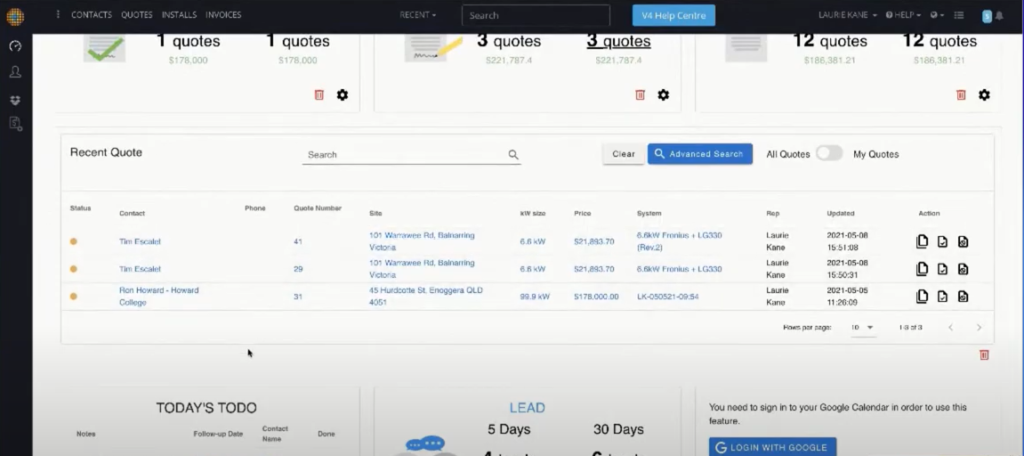
Equally, in the installation process, you’re able to keep track of where things are at with all of your installations, make sure that every box gets ticked in terms of documentation, checking and following right through to completion and handover of information for the customer.
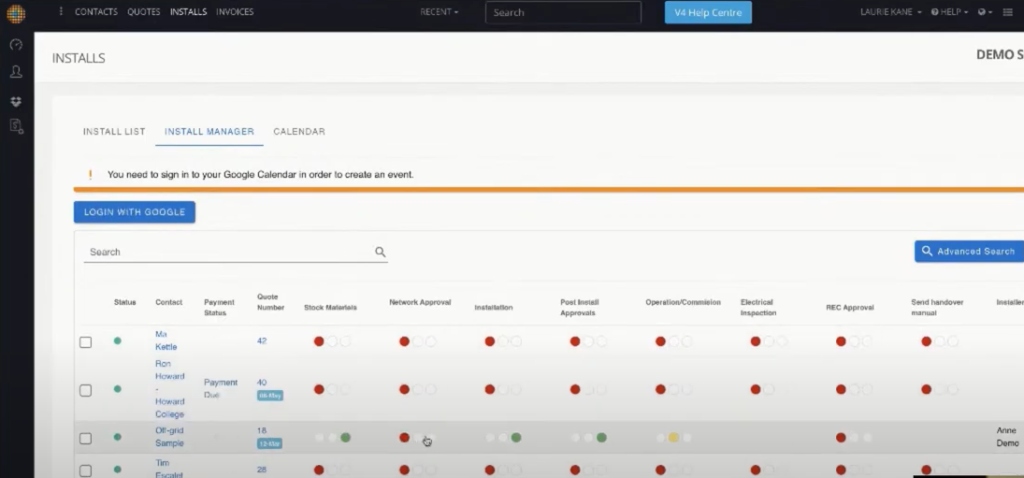
But one of the really important things is to give a good estimate of the performance of a system and its performance over the lifetime. We’ll be able to see how the offer stacks up financially for the customer, be able to demonstrate it and give the customer confidence in what you’re offering and in your service.
Let’s do a quick quote for mum for mother’s day! It starts with just typing in the address of the prospect and using the magic of google maps or other mapping services.
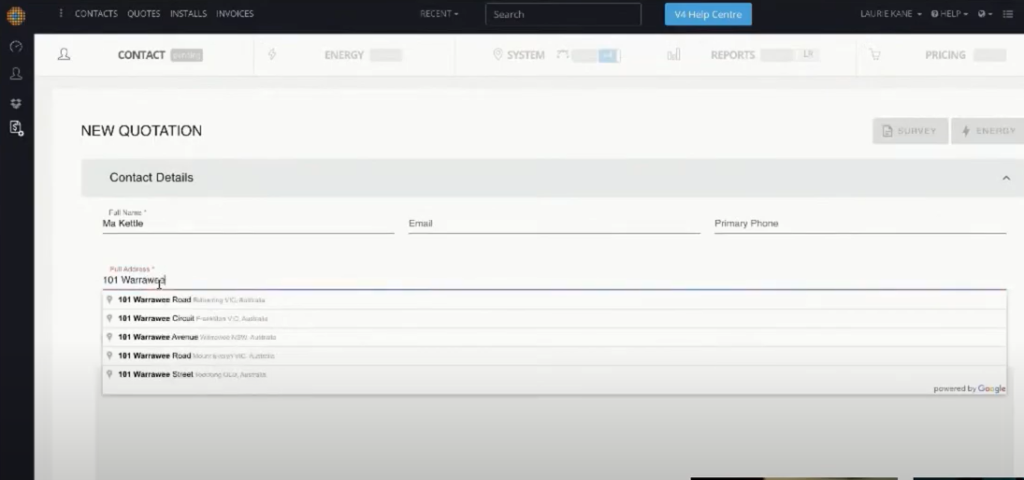
It brings up the address and a nice satellite picture. For installers, you do want to install a system for your mum before one of those less reputable solar companies rings are up and then she gets excited, signs up, and ends up with a problem that you might have to go out and fix. Do the right thing, sort out your mum with a system.
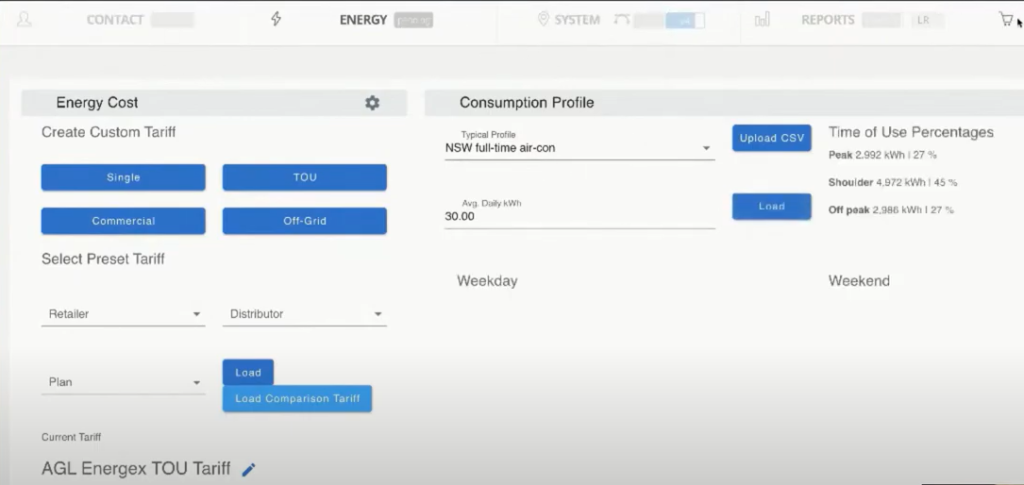
The Easy Solar Quoting Process in SolarPlus
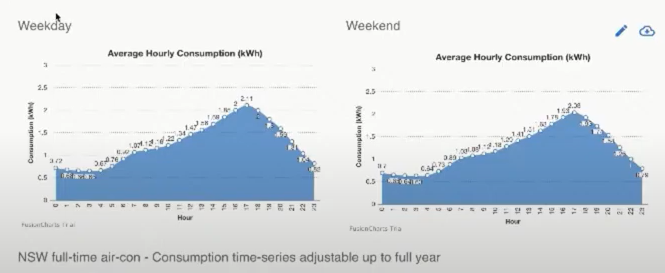
Select a tariff, it’s going to be a time of use tariff and an energy consumption profile for the house. We’ve used a typical profile but in the best-case scenario, you’re able to upload interval data from the actual house, customer, or your mum’s energy information from the retailer or the network provider. In that case, you’ve got a better basis for the quote and for the performance analysis of the system.
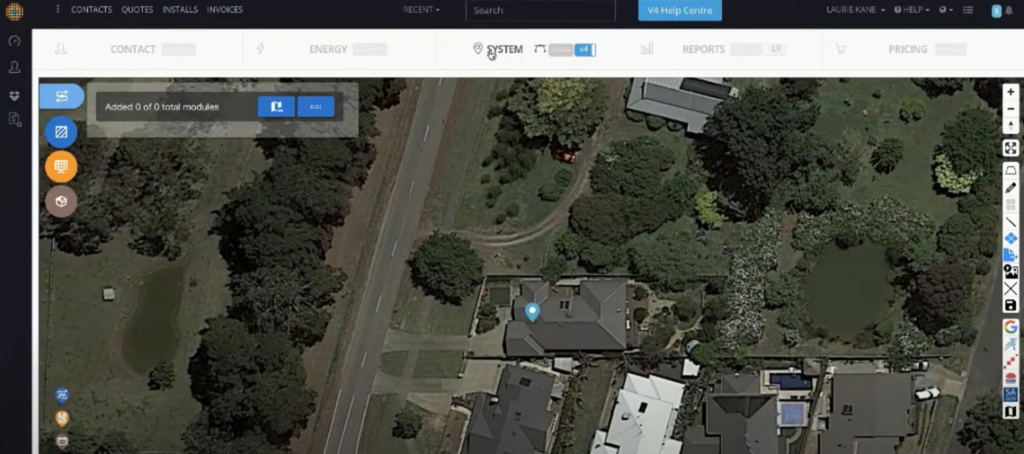
But then we can go through and look at the house, we might switch to a nicer option for the panel layout with better imagery. There’s about six different options in SolarPlus from Google, Nearmap, MetroMap and a couple of others. A couple of those are photo map services where you’re not dealing with imagery taken from a satellite which can be a little bit less reliable, less accurate in terms of spatial accuracy. As you can see in the image below we try to get fairly accurate with the size of the surface that we create here in order to have maximum confidence of the panels fitting when we get to the job and look at the actual roof.

It gives us a quick indication of a system size that we might want to select. We can look through some of our system options and select some good components for mum. She deserves it!
Grabbing that system package means we’ve got a pre-built system there that we can apply, do the panel layout and generate a quote. We just drag them on to the roof.

Sometimes you need to knock out a few panels because of some obstructions in the roof and it tracks what you’re doing with the panels so that it is giving you an indication of where and when you’ve got a match between your pre-built system and the system that you’re going to lay out.
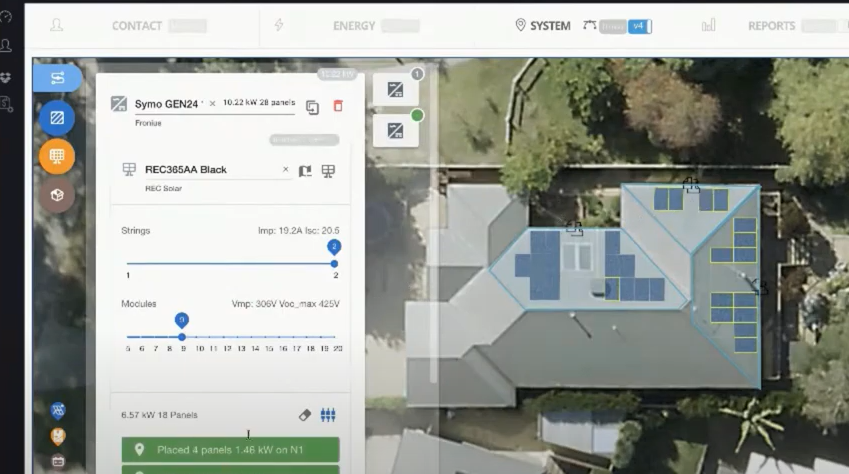
In some cases here we might actually want to swap from one surface to another so there are some nice ways to get that down fairly quickly and keep track of the system size as you go. We put panels on different surfaces some of which are in different orientations and inclination. For each panel, it’s going to do a performance analysis on the surface that it’s on, the angle that it’s on, and run through them for every panel in its position. That’s one of the benefits of a system like this.
We pull in very localised weather data. It’s actually a 10 square kilometre grid of weather data across the country and that means we can get very reliable modeling across the system and across the lifetime of the system. It’s pulling in the solar radiation data as well as temperature, wind and a whole lot of information about the site.
Sometimes we get the question is it worth putting panels on the south roof or the west roof – you can show the performance difference with the software. In some situations, you could even put panels on a south-facing roof, definitely on east and west. In more northern areas of Australia, you can get very good output from panels on even a south-facing roof. There are a lot of options and the installer has a lot of ability to swap things up.
Having done one quote for a customer and generated performance analysis already, we could now just duplicate that and switch the panels to different surfaces to run another scenario within a minute or two.
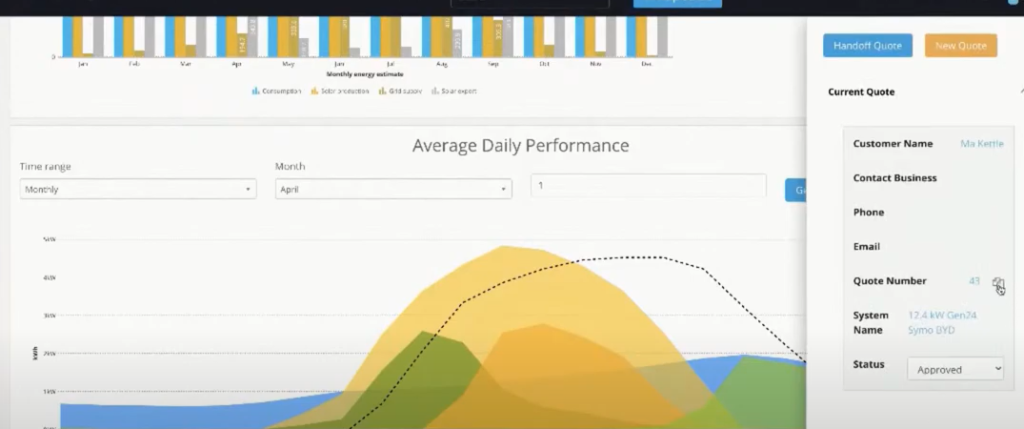
And that’s one of the advantages of a software platform like SolarPlus. You’re not doing things over and over again. You’ve got that reusability right throughout the system.
We have come into an energy report below where there’s lots of information about what happens on an average day. The consumption overall for the site, how much are we still relying on the grid, how much should we cover with solar being used directly during the day or solar being stored and used overnight.
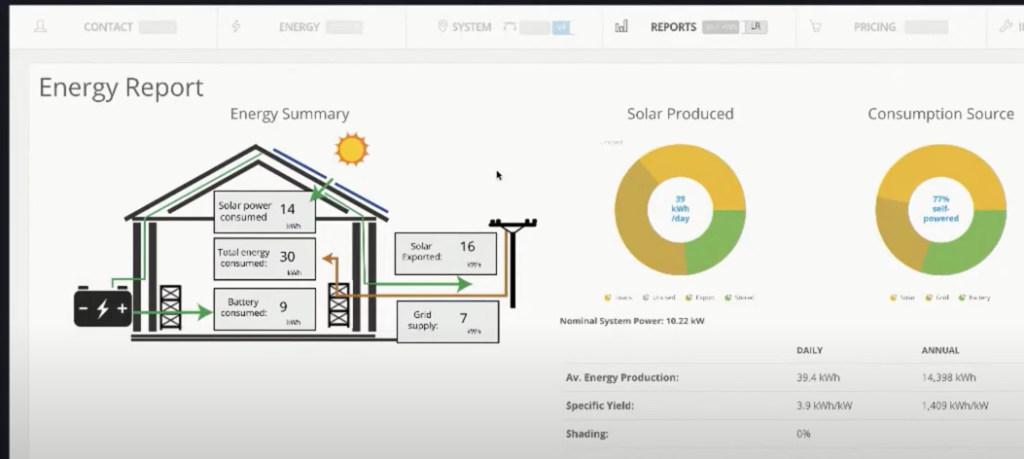
A Quick History of SolarPlus
Ten years ago we were struggling with manual means of doing solar. We were doing it with spreadsheets, calculators, and data sheets and really the initiative to come up with a better solution. The first iteration was a bigger spreadsheet which probably lasted about a day. We realised that was not going to work. We realised that software and certainly using a web-based platform makes it very accessible.
That’s how SolarPlus came to be. It’s based on the learning of people who’ve actually worked in the industry and many of our support staff are actually directly involved. We’ve got a lot of hands-on experience. In terms of us starting out that journey, the Smart Energy Council was an important player in that. They have done an amazing job over the years of advocating not only for installers but for consumers making sure that the environment for solar has been a healthy one. Hats off to the Smart Energy Council.
Solar Power Installation and Payback Periods
Almost everywhere in Australia you’re going to find that solar pays for itself in maybe 4 or 5 years. That is the most common timeframe across all states and some states have extra incentives. You can do even better than that. Keeping in mind that you’ve got a system that’s producing power for 25 years or more, there’s plenty of reasons to get on board no matter where you are.
Australia is the highest per capita installer of residential solar in the world now because we are an excellent sunny country. This is just to reinforce the point that just about anywhere in Australia, a solar power system will probably pay for itself in a modest period of time, certainly before the product warranty is over.
Over the years, the cost of the components, the cost of solar panels particularly, has just dropped dramatically to a point now where they’re probably not going to get a whole lot cheaper. They’re really great value for the price and at the same time for a lot of installers because of the competition they have had to really get more efficient and more lean. That’s one of the ways in which software can help to enable installers to do things without so much of that compliance, time and effort that has gone on in the past.
We need to be shouting out that Australia is really good at installing solar as well as using it. We remember some researchers from the Rocky Mountain Institute in California came to Australia about 7 years ago to find out why solar was so cheap here. What the outcome was is that we’re just really very good at it through experience. We’ve done a lot of residential solar and now a lot of commercials and we’re using tools and products that speed up our practices.
To some extent, our roofs help too. If you’ve ever worked in the US, you know that those shingle roofs are a nightmare to install solar on. We should be really proud of our industry’s quality and performance. We have got incredible capacity in this country and you’ve seen the rate of uptake in solar over the years.
There are a lot of skilled people out there not only in solar but now in storage and a few years ago that was a bit of a concern where suddenly Tesla was out there promoting Powerwall as the new thing. Suddenly consumers wanted to jump on board and have a Powerwall next to their front door. There was fear and reputation risk in the industry that there weren’t enough people that were skilled, able to get battery systems installed, and do it safely.
Credit to the industry bodies and installers for getting in work on training and understanding the products, what they can do, what they can’t do, what’s the best product to offer and the actual practical install know-how and to deliver reliably. We’ve provided support and training to installers all over the country for that too and a lot of it online like this.
Battery Performance Reports
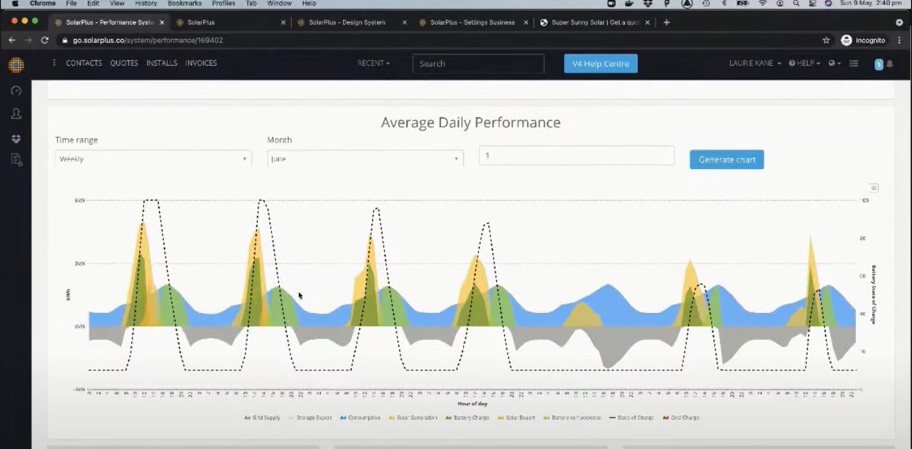
We pick up a load profile for expediency but we can switch back over and grab actual data. This is really important for anyone who is selling battery storage solutions, being able to drill down, not just looking at average days but actually drilling down to the model data in the performance from day to day throughout different periods of the year and particularly those winter months any time where the solar production isn’t going to be so high.
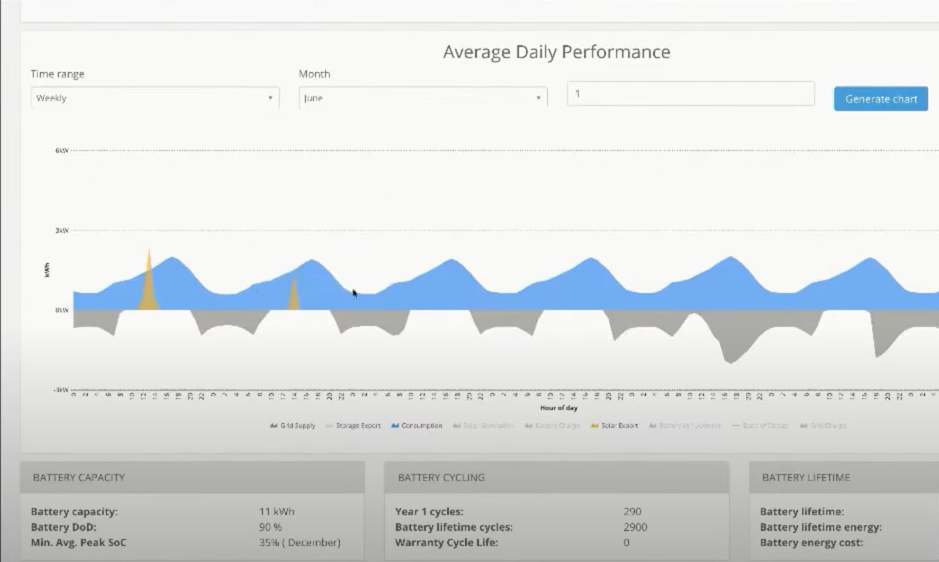
We can see a detailed chart. We could drop some of these values out to break things down. We’ve got the consumption and this is just a typical consumption. It’s just a regular usage cycle. We can see the solar generation and the time of the year. There’s a lot of intermittency in it and so the solar drops out for one of the days. We’re looking at a seven-day view and in this case we can start to think about the battery charge.
We’re able to look at the state of charge of the battery so when the battery is topped up and full, when it’s being used later in the day and dropping down and not used overnight in this case. With a view like this you’re able to see what happens when you get a few days of low solar output, low solar production and that battery capacity not being able to ramp up. Certainly, with battery storage systems, there’s a good argument for getting as much solar on a rooftop as you can, particularly in the southern areas where you’re going to experience less solar production in the winter months.
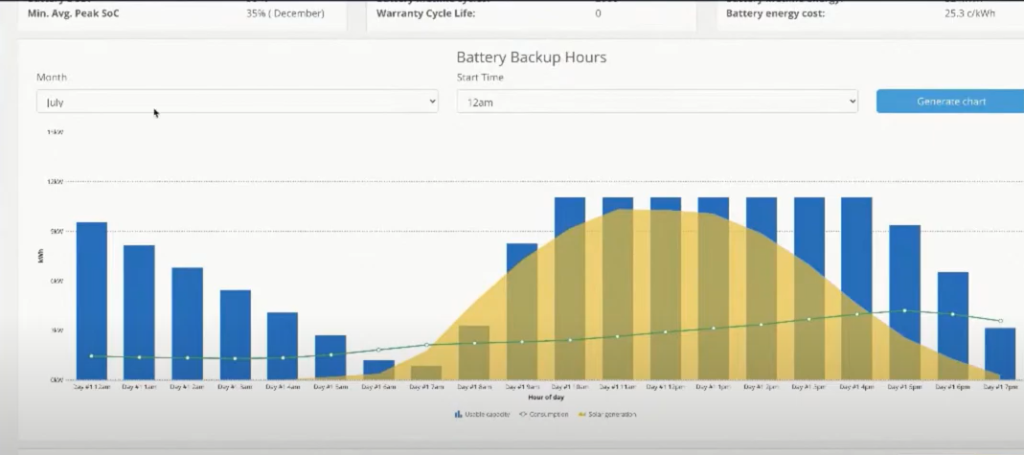
Another valuable thing is a chart that gives us battery backup hours. That’s an indication of how long a battery is going to last if the grid power drops out.
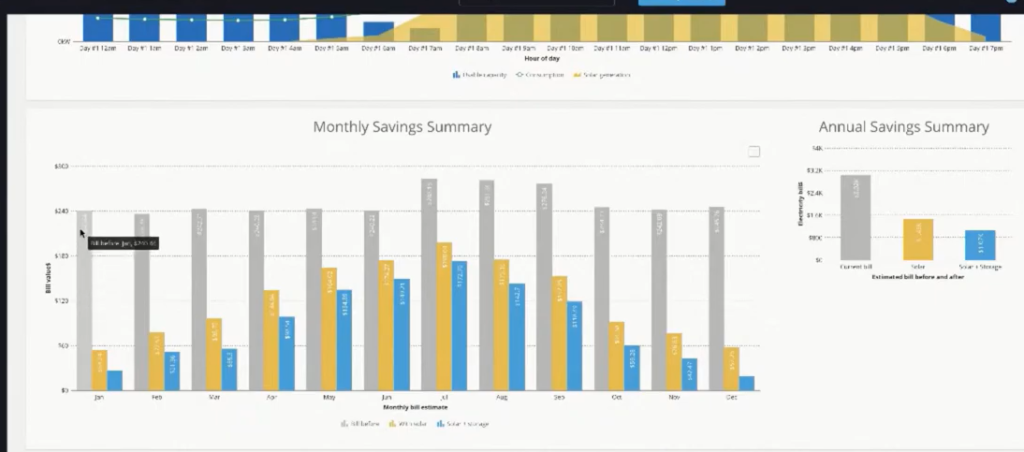
It is a really interesting one for anyone who’s considering a battery system and that is being able to compare their bill before and the bill with solar. You can see a dramatic drop in the cost in the summer months particularly and then the bill comparison with solar and storage. So that’s an important thing to consider, there’s a big benefit in installing sola. It’s very important to be able to quantify that and give the customer an accurate picture of what their energy bills are going to look like after the system has been installed and what sort of payback time they might be looking at.
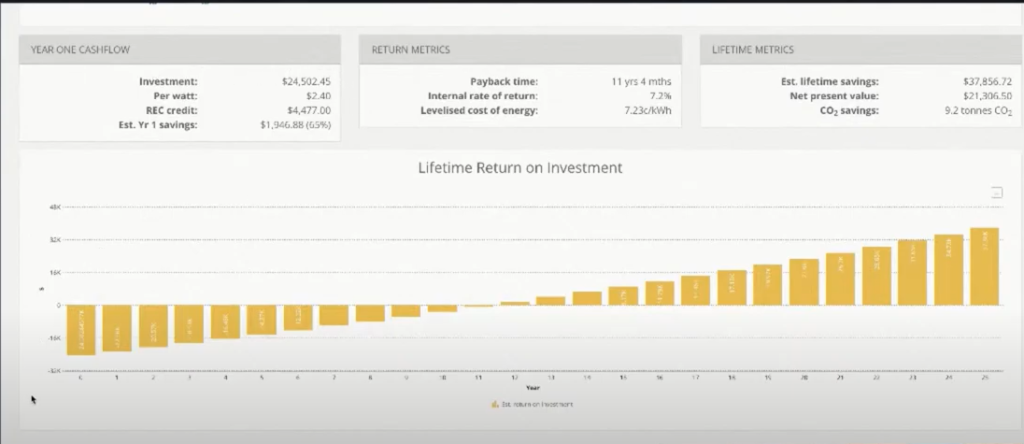
This is a battery storage system with about a 10-year payback. You could then model it without the storage and see what the payback is equally. You could do a comparison. We duplicate that system, drop out the storage and take a look at the scenario where it is just solar.
Follow up questions from our livestream
What methods do you use to import/create the load profile when it’s a customer-specific sizing exercise?
We’ve got two options. One, if you can get customer load data with the advent of smart meters in many states around Australia, the customer by request to the electricity distributor, can get the 30-minute interval data from the retailer or from the distributor that can then be imported directly into SolarPlus. We’re using the real data and doing modeling based on that. The second option is predefined load profiles based on you know what state you’re in, what type of energy use pattern you have, do you have an electric vehicle, do you have air conditioning etc., and we can use that as a rough guide.
There are several formats that will come from different sources that allow you to import and hopefully you have at least a year of data. If you don’t, it will be extrapolated out to a full year because in any modeling situation we’re looking at a typical year of data. We’re getting a typical year of solar radiation and weather data to do the initial model. Then we’re looking at future years and how the performance will taper off a little on the solar so that you can model on that basis.
SolarPlus System Reports
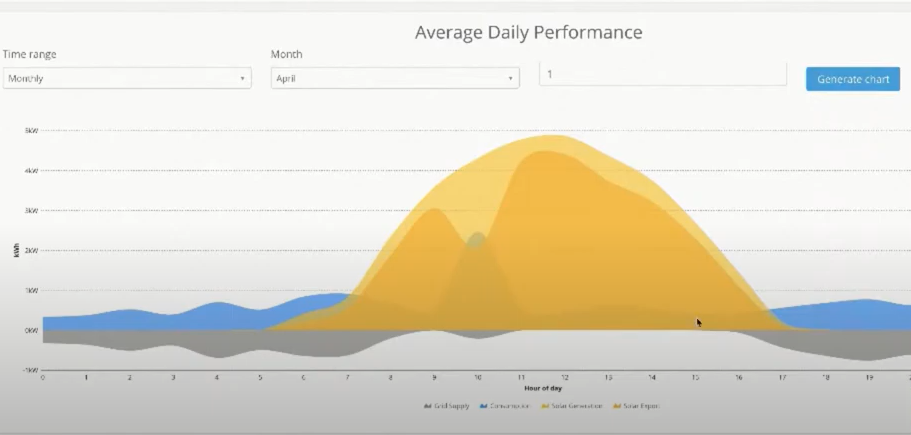
The actual data in the image says variability but it’s not really a typical residential profile. Generally, with a residential profile, you’re going to have much higher consumption in that evening period. This is more of a work from home scenario but yes, it’s quite easy to get that actual data in there in order to model it.

In the image above, we duplicated the system, drop out the battery system and just did a very quick re-jig rather than selecting another package.
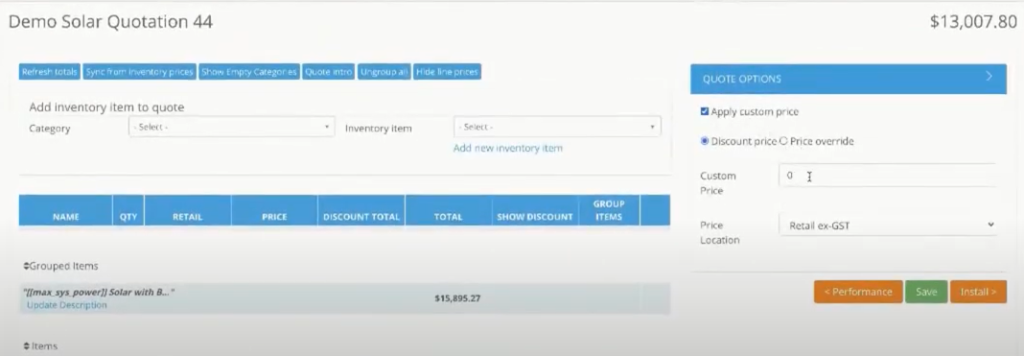
We’ve still got quite an expensive system. Let’s just say for argument’s sake that we’re looking at a $6,000 system as the final price and that’s not outrageous, the higher quality products where a system might be more expensive. We’re just trying to be a little bit realistic here about what might be a fairly common scenario.
In the images below, we see the solar paneling pays itself off in around four years and that’s quite common in this case because we are in New South Wales with this system.

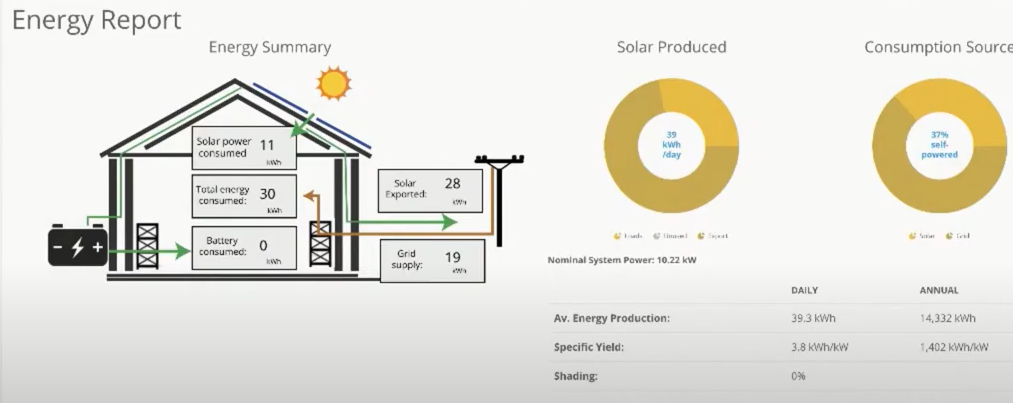
There was a piece of research done by Renew which used to be called the alternative technology association of their member’s systems to find out what the financial benefit to them was and what the analysis they could make of different sized systems was. The report tells you the answer. The report was titled Bigger is better because it identifies that solar has got incentives on the solar panels and not on the balance of systems like the inverter, the racking or the labour.
Putting in a 1 kilowatt system or a 6.6 kilowatt system, there’s a similar amount of work involved. It’s still one inverter, it’s still running a cable to the roof, it still works like the switchboard whether it’s a 1 kilowatt system or a 6.6 kilowatt system. You get a much better return on your investment the bigger it is even if you don’t use the energy. If that energy is being spilt to the grid and you’re not getting a very good feed-in tariff which is the norm these days, then you’re still covering yourself in terms of electricity consumption.
Most of the time, for many people, a 6.6 kilowatt system will cover a large proportion of their self-use during daylight hours and so that’s why the payback looks good.
In Australia, there is very little to be gained by exporting that extra solar to the grid and that’s where batteries are a good use of that energy. You’re offsetting more coal-generated energy as a result. There’s commonly limits on how much can be exported as well, so even if you have just got a solar system, it’s important to also model the export and consider whether there’s any value in it or how much value it is. That also will affect the payback for the customer and the overall value of the proposition.
Are commercial (+400w) panels available for residential use?
There’s no restriction on which panels you can use. It comes down to the design and whether they suit the roof size layout, the voltage and current ratings of the products that you connect them to. Using a physically bigger panel may or may not be an advantage. This is where your installer would need to be consulted. Using the software you can bring those panels onto the roof because we actually have the imagery data and also the measurement data for the panel. When you select a panel, it’s the actual panel that’s being laid out on that roof. We’ve got all the measurements correct and it allows for the error based on the tilt angle of the panel versus what you’re looking down from space.
It does give a very accurate representation. You’d have to ask yourself if it is suitable and why you would use commercial panels.
More on the SolarPlus CRM and Solar Design System
In software like SolarPlus, you can also model off-grid power systems which is quite a different game in many respects in terms of modeling. This is because you’re talking about a diesel generator as a backup and that’s one of the important things, knowing when a diesel generator is going to be coming online. In SolarPlus you can analyse the monthly run time of that generator. You can get a very good picture of the generator reliance, what sort of cost because generators are an expensive thing to run. Also just being able to look at that detailed view of load profile versus solar versus battery supply and battery state of charge.
We can look at the monthly consumption, the solar production and as a result the grid supply or in the case of an off-grid system, the generator supply and the generator run time. We can look at the solar export and having all of those metrics, measurements and details at your fingertips is invaluable if you’re pitching a system to a customer and it is important to be able to answer their questions.
Compare the value of affordable mapping, pro design features, slick proposals & massive time-saving on automation of documentation! Here are the SolarPlus plans.
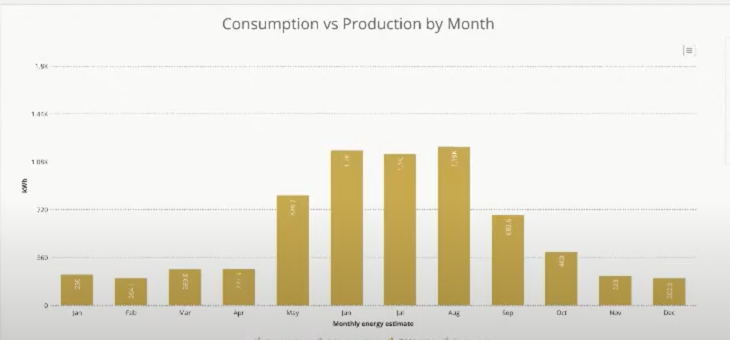
Helpful Information to Solve Common Headaches in Solar
Avoiding the most common sales errors
Let’s look at a few things that installers might face and things that might be helpful in terms of sales but also some of the things that can be headaches for installers and how SolarPlus will help.
1. Not following up fast enough
We talked a little bit about tracking. SolarPlus makes it easier to follow up with leads, tracking installations and prepare compliance documentation.
2. Assuming solar understanding and motivation
We don’t have a lot of research on this in Australia but there’s some really interesting stats in terms of sales and up to 200% conversion increase if a quote is out to a customer in minutes. That might be a big ask but it can be done with even a 17% conversion increase within a day. Getting that information out to customers quickly is really important and having those system packages or pre-built and ready to go helps. As a way to do that, sometimes it could take a little more time but it’s worth asking the customer questions about what they’ve learned so far in their research and you’ll probably find out if they’ve already got quotes, maybe even how much they are and what their priorities are. Are they energy conscious? And are they driven by reducing their coal energy use in which case you might have a different solution for them as opposed to someone who’s purely interested in financial reasons.
Work on educating the customer. That’s a good part of the value and builds that relationship with them.
3. Not maintaining contact for long enough
There is research that the average time to commit from when a consumer first started thinking about solar to when they actually committed and purchased was nine months. That’s a long time to be keeping track. There are ways with something like SolarPlus to apply tags and use email templates to just keep reaching out until that customer’s ready to move. It is challenging for an installer to manage that so you have to have those systems ready to go and repeatable in order to do it painlessly.
Custom Solar Proposals to Tell a Story
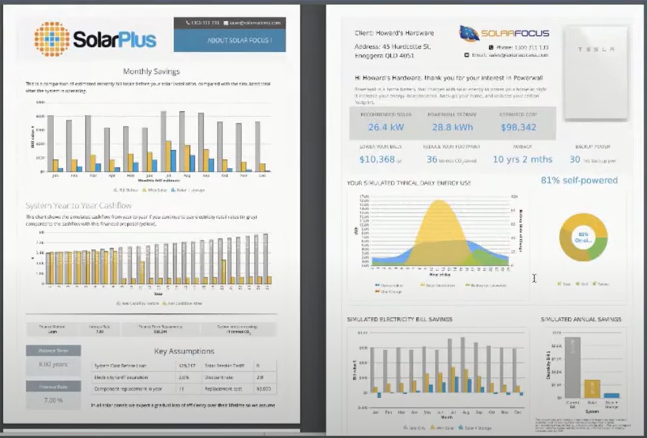
It is important to tell a story in your own way. In our system, we’ve got out-of-the-box proposals that you can get up and running within a day or two but you can also customise them to tell the story you want to tell in your own way or just have different proposals ready for different types of customers.
Tips to Improve Solar Quote Conversions
1. Address customer objections
Some things that you might need to address in terms of common customer objections are that some people that feel that solar is ugly. You might want to just present a nice beautiful picture of the array on the rooftop and that’s where it is worth spending a little bit more on, some good quality imagery from Nearmap or MetroMap.
2. Lack of confidence in the unknown
Demonstrating with good energy modeling is a great way to provide confidence. A lot of installers struggle with it and comments like “it sounded like it would be much cheaper on the ads we’ve seen”. People will be seeing ads for really cheap solar systems but it’s worth reminding people that they’re cheap, it might be attractive but just like buying a cheap car there’s a high likelihood of regret.
3. Offer choice
We want to offer you a high likelihood of satisfaction, that’s why we’re providing you a quote with a reasonable price for a good quality system.
New Features in SolarPlus
There is a cool new feature in SolarPlus. We talked about showing solar in its best light and in terms of the panel layout we can now switch through different types of panels to show a really attractive image of the rooftop.
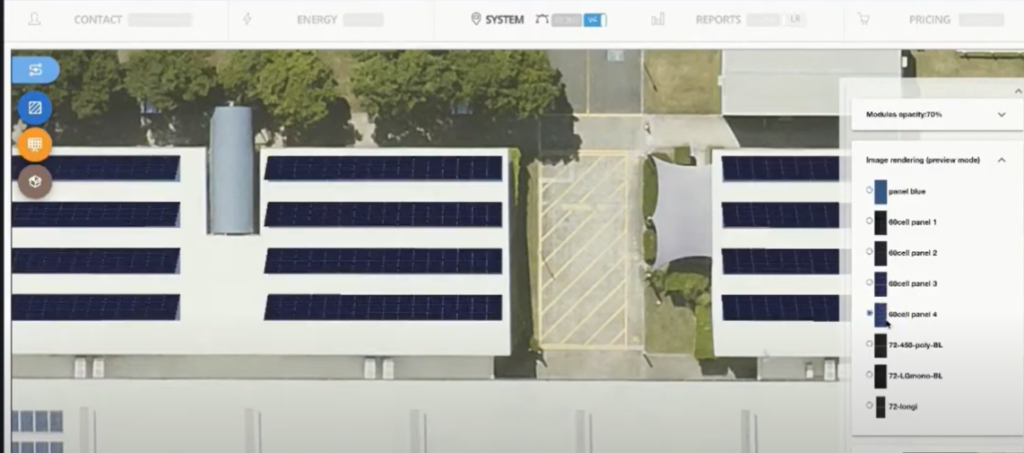
We are also just about to release a new 3D mapping update to SolarPlus so in terms of shading and particularly commercial systems, it’s really great to be able to generate that 3D imagery, work out spacing between rows of panels and get your customer excited with some 3D views of the install going on the rooftop.
SolarPlus is a complete solar design software platform to win you more happy solar customers, save you time, and maximise your profits. Start today! Contact us if you are ready to grow your solar sales business.


